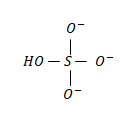
In bisulphate ion, the formal charge on the sulfur atom is:
A. \[+1\]
B. \[+2\]
C. \[+4\]
D. \[+6\]
Answer
552.9k+ views
Hint: Formal charge of an atom in a molecule can be found by the relation: $formal\,charge=valence\text{ }electrons-\left( non-bonding\text{ }valance\text{ }electrons \right)-\dfrac{\left( bonding\text{ }electrons \right)}{2}$
Using the above relation, find the formal charge on the sulfur atom in bisulphate ion.
Complete step by step answer:
We know that the relation to find the formal charge mathematical can be expressed as shown below:
$formal\,charge=valence\text{ }electrons-\left( non-bonding\text{ }valance\text{ }electrons \right)-\dfrac{\left( bonding\text{ }electrons \right)}{2}$
The structure of the bisulphate ion is as follows:

In which the middle atom is the sulfur atom.
The valence electrons of the sulfur atom is = 06 electrons;
The non-bonding valence electrons of the sulfur atom in the above molecule is = 0 electrons;
The bonding valence electrons of the sulfur atom in the above molecule is = 08 electrons.
Put all these values in the above formula and calculate the formal charge
After substituting all the values in the above relation we obtain
$formal\,charge=6-\left( 0 \right)-\dfrac{8}{2}\text{ = +2 }$
Therefore the required formal charge on the sulfur atom in the bisulphate molecule is \[+2\]
Hence option (B) is the correct answer.
Note: Formal charge can be defined as the charge assigned to an atom in a molecule, assuming that electrons in all chemical bonds are shared equally between atoms, regardless of the relative electronegativity.
The formal charge on an atom in a molecule reflects the electron count associated with the atom compared to the isolated neutral atom.
Using the above relation, find the formal charge on the sulfur atom in bisulphate ion.
Complete step by step answer:
We know that the relation to find the formal charge mathematical can be expressed as shown below:
$formal\,charge=valence\text{ }electrons-\left( non-bonding\text{ }valance\text{ }electrons \right)-\dfrac{\left( bonding\text{ }electrons \right)}{2}$
The structure of the bisulphate ion is as follows:

In which the middle atom is the sulfur atom.
The valence electrons of the sulfur atom is = 06 electrons;
The non-bonding valence electrons of the sulfur atom in the above molecule is = 0 electrons;
The bonding valence electrons of the sulfur atom in the above molecule is = 08 electrons.
Put all these values in the above formula and calculate the formal charge
After substituting all the values in the above relation we obtain
$formal\,charge=6-\left( 0 \right)-\dfrac{8}{2}\text{ = +2 }$
Therefore the required formal charge on the sulfur atom in the bisulphate molecule is \[+2\]
Hence option (B) is the correct answer.
Note: Formal charge can be defined as the charge assigned to an atom in a molecule, assuming that electrons in all chemical bonds are shared equally between atoms, regardless of the relative electronegativity.
The formal charge on an atom in a molecule reflects the electron count associated with the atom compared to the isolated neutral atom.
Recently Updated Pages
Master Class 12 Business Studies: Engaging Questions & Answers for Success

Master Class 12 Economics: Engaging Questions & Answers for Success

Master Class 12 English: Engaging Questions & Answers for Success

Master Class 12 Maths: Engaging Questions & Answers for Success

Master Class 12 Social Science: Engaging Questions & Answers for Success

Master Class 12 Chemistry: Engaging Questions & Answers for Success

Trending doubts
What is meant by exothermic and endothermic reactions class 11 chemistry CBSE

Which animal has three hearts class 11 biology CBSE

10 examples of friction in our daily life

One Metric ton is equal to kg A 10000 B 1000 C 100 class 11 physics CBSE

1 Quintal is equal to a 110 kg b 10 kg c 100kg d 1000 class 11 physics CBSE

Difference Between Prokaryotic Cells and Eukaryotic Cells




